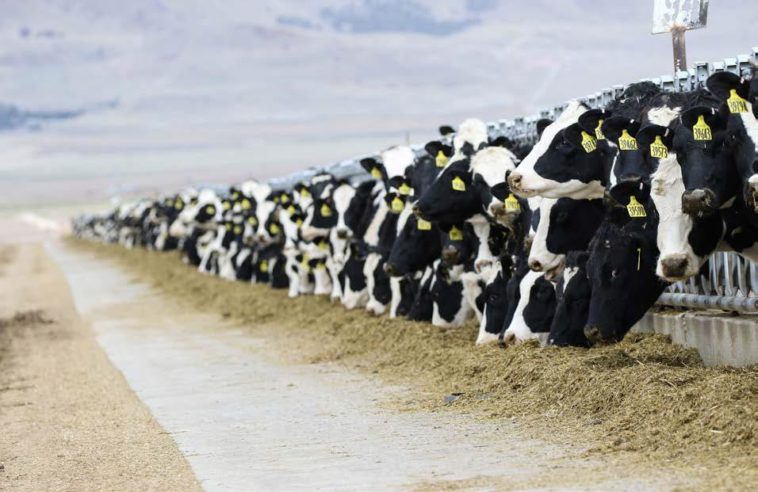There is a wide variety of options to choose from when constructing a dairy parlour. These parlours are costly to build; therefore, you will mostly find them on commercial dairy farms. When milking only a few cows for household purposes, it is cheaper to milk by hand.
The design of milking parlours and milking parlour equipment is a subject that takes up the time of a great number of experts in animal housing and agricultural engineering. New developments of milking machines, equipment and parlours are taking place daily. The milk centre, consisting of the milking parlour, holding pen and head-off facilities is more than just a place where cows are milked.
Cows are observed here during the milking sessions. Information that is needed for managerial purposes can be obtained by means of visual observation or electronic systems. The milk centre is the centre of the management of a dairy and can play an important role during the implementation of the management programme of the farm (Bickert, 1992).
Decisions on the milk centre’s layout and construction are therefore more than merely decisions pertaining to the choice and design of the milking parlour. Thorough planning is essential to ensure that all components are economically viable and contribute to the management plan of the farm (Bickert, 1992).
The choice of the type and size of a milking parlour, as well as the level of mechanisation to milk the herd, and possible extensions, is determined by the following factors (Armstrong, 1992):
A milking parlour normally has a life-span of 10 to 20 years. The total size of the herd must therefore be considered for the following 10 to 20 years and not only for the current number of cows. If extension of the herd will take place within the next five years, it is usually more economical to design the milking parlour for the final herd size. If the maximum herd size will however only be reached in 5 to 15 years’ time from the starting date, consider leaving space for expansion in the milking parlour and holding pen during the original construction. Additional milking machines can then be purchased and installed later when needed (Armstrong, 1992).
The milking time of any herd must preferably not exceed two hours. A rule of thumb to determine how many milking points are required is to accept that one milking point can milk 7,5 to 10 cows per hour. According to this, eight milking points can milk 60 to 80 cows per hour or 120 to 160 cows in two hours (Engelbrecht, 1991).
The number of milking points that can be controlled by one labourer depends on his/her skill and dependability and also, to a certain extent, the production level of the herd (Engelbrecht, 1991). As a rule of thumb, it can be accepted that one labourer can control four milking points.
The selected milking parlour must ensure a good flow of the cows, with the minimum number of turns for cows at the entrance and exit. The effectiveness of any milking parlour is reduced by poor flow of cows that hinder the labourers in their task (Engelbrecht, 1991). Dairy owners usually have personal preferences for a specific milking parlour. These preferences are often in conflict with the number of cows to be milked, the duration of a milking session and the financial capacity of the farmer. Prospective dairy farmers should visit all types of parlours to compare them and make a final decision on the type that would be the most suited for his venture (Armstrong, 1992).
Milking parlours are available in various types and sizes, of which the choice can be influenced by the factors as discussed. The type of parlour influences the size of the building, the flow patterns of cows, milking routine and the type and level of mechanisation that can be used efficiently. In general, it does not influence the quality of milking. A good milking system can be installed in any type of parlour and good milking procedures can be followed, irrespective of the type of parlour.
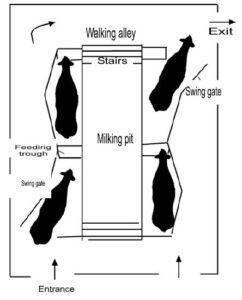
Figure 1: Side-gate type tandem parlour.
The following paragraphs give a description of each type of parlour, as well as the benefits and disadvantages of each:
Tandem parlour
Tandem parlours usually have two to six milking stalls at each side of the pit. A study for South African conditions showed that four units must be placed in tandem and thereafter a double row can be formed (this is more suitable to the local labour) (Smith, 1998).
There are two types of tandem parlours, namely the side-gate type (see Figure 1, p 12) and the walkthrough type (see Figure 2, p 12). The side-gate type has entrance and exit gates on the one side of each milking stall that can be operated by hand or hydraulics. The walk-through type has sliding gates in the milking stalls. In both cases the cows stand head-to-tail and parallel to the milking pit (Engelbrecht, 1991). Tandem milking parlours are especially suitable for smaller dairies (fewer than 100 cows), or for stud farming.
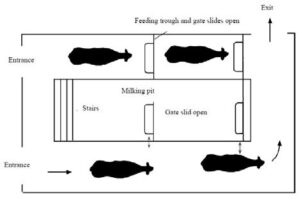
Figure 2: Walk-through type tandem parlour.
Benefits:
- The side-gate type allows cows to be handled individually, cows that milk slowly do not delay the others.
- The walk-through type is a much cheaper and simpler construction, as it only has sliding gates and one railing.
- The total side of the cow and milking system is visible for inspection purposes.
- About 7,5 cows can be milked per hour per milking point, which is reasonably fast.
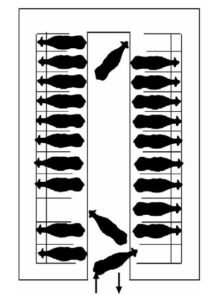
Figure 3: Parallel parlour.
Disadvantages:
- The gates of the milking stalls make a lot of noise during opening and closing. It is bothersome for the cow and can influence milk production negatively.
- The side-gate type requires more steel railing construction than the walk-through type and also a larger building surface.
- With the walk-through type, all the cows have to be milked before they can be let out.
- The most important disadvantage of both types is the greater distance that the labourers must walk between the udders of the cows to fit the claw-piece. It plays an important role when the parlour is mechanised, as more milking stalls are required, resulting in the milking pit becoming too long (Bickert, 1992).
- Greater construction and material costs per milking point in comparison with other types of parlours.
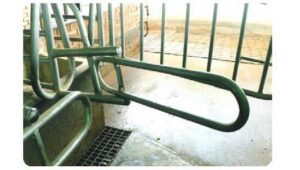
Figure 4: Partitioning gate.
Parallel parlour
In these types of parlours cows stand side-by-side at an angle of 90° with the milking pit, with their heads turned away from the labourers and pit (see Figure 3). This orientation means that the claw-pieces are put on between the hind legs. The distance between the udders is approximately 630 to 710 mm.
A partitioning door that swings when a cow enters the milking stall opens the adjacent milking stall for the next cow (see Figure 4). In most parlours, the gates overlap to prevent the cows from entering the milking stall beforehand. As a cow enters the parlour, there is no milking stall available to enter, except the last one in the line (Armstrong, 1992). Cows leave the milking stalls via the front if they do not receive power fodder during milking. However, if they receive power fodder during milking, all the milking stall partitions will have to be raised hydraulically simultaneously, as the cows cannot leave the milking stalls via the front, as a result of the feeding troughs (see Figure 5a and 5b).
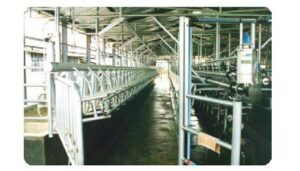
Figure 5a: Milking stall partitions in the normal position.
Benefits (Smith, Armstrong, Gamroth, Welchert & Wiersma, 1993):
- A large number of cows can be milked in a small space.
- As the udders of the cows are closer together, the walking distance for labourers is reduced by 35%. Claw-pieces can therefore be fitted faster.
- First lactation cows adapt easily to a parallel parlour, as their orientation and position in relation to other cows are the same as what they are used to at the feeding troughs.
It is a smaller risk to milk a cow from between the hind legs than from the side. With the bottomrailing of the spatter panel 710 mm above the platform on which the cow is standing, it is impossible for her to kick the labourer, except if the cow is short or if the labourer extends his hand past the manure railing on purpose. This measurement is critical, as a height of smaller than 685 mm reduces visibility of the udder, while a height greater than 735 mm is inclined to place the manure channel too high.
With the cows standing level with the milking pit, the kicking off of claw-pieces is reduced, as there are no pipes on the cow’s side that she can kick.
- Building construction costs are lower and correct construction geometry is easier to obtain when equipment is installed at 90° angles.
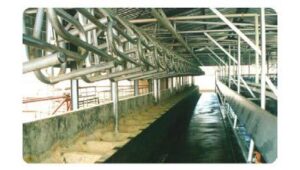
Figure 5b: Milking stall partitions in the raised position.
Disadvantages (Smith et al., 1993):
- The greatest disadvantage of the parallel parlour is the problematic tail position and the question of what to do about handling it.
- Dairy farmers and labourers without experience of parallel parlours are hesitant to milk cows from between the hind legs and consider this a disadvantage.
Published with acknowledgement to the ARC Agricultural Engineering for the use of their manuals. Visit www.arc.agric.za for more information.

